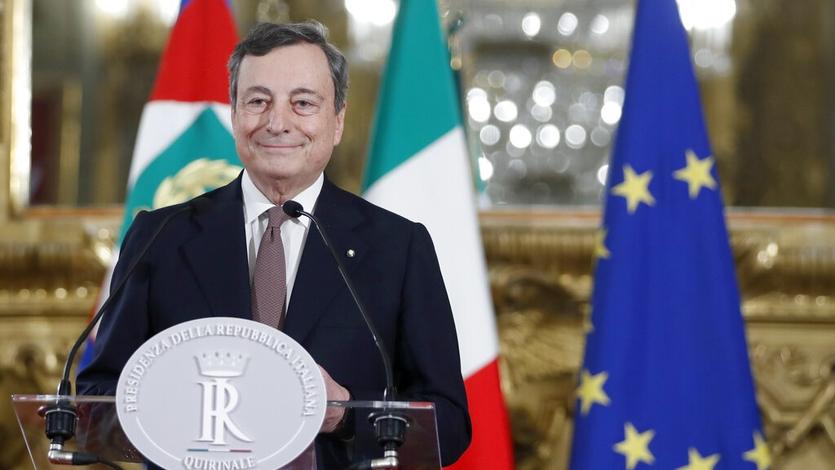 Incoming Italian Prime Minister Mario Draghi speaks to the media after meeting with Italian President Sergio Mattarella, in Rome, Italy, Feb 12, 2021. (YARA NARDI / POOL PHOTO VIA AP)
Incoming Italian Prime Minister Mario Draghi speaks to the media after meeting with Italian President Sergio Mattarella, in Rome, Italy, Feb 12, 2021. (YARA NARDI / POOL PHOTO VIA AP)
MILAN - Prime Minister Mario Draghi has put climate change at the heart of his plans to run Italy by creating a superministry to ensure a transition to green energy drives recovery and makes full use of European Union funds.
Draghi’s first job will be to redraft Italy’s Recovery Plan, which must be handed to the European Commission by April to tap more than 200 billion euros (US$240 billion) of funds needed to revive the recession-hit economy.
PM Mario Draghi’s first job will be to redraft Italy’s Recovery Plan, which must be handed to the European Commission by April to tap more than 200 billion euros (US$240 billion) of funds needed to revive the recession-hit economy
Under an EU agreement, 37 percent of this money must be dedicated to the transition to a low carbon economy.
The former European Central Bank chief, who took office on Saturday as the head of a unity government created to steer Italy out of the coronavirus crisis and economic slump, has picked physicist Roberto Cingolani to head a new ecology transition ministry.
“Ours will be an ecological government,” Draghi told his first cabinet meeting on Saturday.
In his role, Cingolani will take over energy matters previously shared with other ministries and combine them with the environment portfolio.
ALSO READ: Italy's parties enthuse over Draghi, 5-Star postpones vote
Chief technology and innovation officer at Italian defense group Leonardo and a Ferrari board member, the 59-year-old has worked in top scientific research centers in Germany, Italy, Japan and the United States, focusing on robotics, artificial Intelligence and “digital humanities”.
His appointment is a sign of Draghi’s intention to involve experts in employing the EU recovery fund and picking the right technologies to drive long-term development.
The creation of the new ministry helped to win over Italy’s 5-Star Movement, which prides itself on its green credentials, but had faced internal strife over the prospect of joining a cabinet containing its political foes.
“Since the first round of consultations with the political parties, Draghi put the ecology transition at the top of his agenda,” said Vito Crimi, leader of the 5-Star.
Limited Scope
However, some 5-Star members were disappointed the new ministry will only absorb the energy arm of the industry ministry and not the rest, which includes business crisis resolution and international trade.
For some, it also falls short of the more ambitious French model for its transition ministry, championed by President Emmanuel Macron, which oversees transport and infrastructure - though Cingolani will head an “inter-ministerial Committee” Draghi will set up to coordinate the transition.
ALSO READ: Italy's Draghi accepts challenge to form govt as parties hesitate
But businesses hope the new superministry will solve a problem created by the industry and environment ministries’ overlapping responsibilities for authorizing projects.
“The two ministries have a history of not seeing eye to eye and often reflect different political agendas,” Davide Tabarelli, head of think tank Nomisma Energie, said. “Putting the transition under one roof should streamline things.”
Climate policies are central to the Brussels agenda, which wants to reach net zero emissions by 2050, and some countries have already set up separate ministries, including France, Spain and Portugal to help deliver the goal.
Draghi’s move comes as Italy prepares to co-host with Britain climate talks later this year, which are expected to raise ambitions now President Joe Biden has brought the United States back into UN efforts to curb global warming.
It also coincides with Italy’s difficulties in meeting green targets as red tape slows the development of renewable energy, which could thwart its plans to use European funds to the full.
Many companies have complained that an overly-complicated permitting process is holding back projects.
“This is putting the Recovery Fund at risk. Some 70 percent of the grants will be disbursed between 2021 and 2023 and need to be spent by 2026, which is impossible if permits are not there,” one source involved in the Recovery Fund process, said on condition of anonymity.
In December, EU leaders agreed to cut their net greenhouse gas emissions by at least 55 percent from 1990 levels by 2030, toughening an existing 40 percent target.
That puts pressure on Italy to overhaul the energy plan it introduced last year calling for renewables to make up 30 percent of final energy consumption by 2030, from 17 percent in 2019, and for green capacity to rise to 95 gigawatts from 55 GW.


